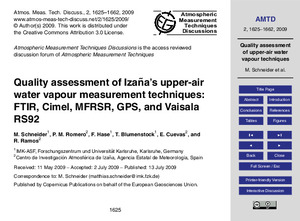Por favor, use este identificador para citar o enlazar este ítem:
http://hdl.handle.net/20.500.11765/6564
Continuous quality assessment of atmospheric water vapour measurement techniques: FTIR, Cimel, MFRSR, GPS, and Vaisala RS92 [Discussion paper]
Registro completo de metadatos
| Campo DC | Valor | Lengua/Idioma |
|---|---|---|
| dc.contributor.author | Schneider, Matthias | es_ES |
| dc.contributor.author | Romero Campos, Pedro Miguel | es_ES |
| dc.contributor.author | Hase, Frank | es_ES |
| dc.contributor.author | Blumenstock, Thomas | es_ES |
| dc.contributor.author | Cuevas Agulló, Emilio | es_ES |
| dc.contributor.author | Ramos López, Ramón | es_ES |
| dc.date.accessioned | 2017-03-13T07:34:10Z | - |
| dc.date.available | 2017-03-13T07:34:10Z | - |
| dc.date.issued | 2009 | - |
| dc.identifier.citation | Atmospheric Measurement Techniques Discussions [Preprint]. 2009, 2, p. 1625–1662 | es_ES |
| dc.identifier.issn | 1867-8610 | - |
| dc.identifier.uri | http://hdl.handle.net/20.500.11765/6564 | - |
| dc.description.abstract | At the Izaña Observatory, water vapour amounts have been measured routinely by different techniques for many years. We intercompare the total precipitable water vapour (PWV) amounts measured between 2005 and 2009 by a Fourier Transform Infrared (FTIR) spectrometer, a Multifilter Rotating Shadow-band Radiometer (MFRSR), a Cimel sunphotometer, a Global Positioning System (GPS) receiver, and daily radiosondes (Vaisala RS92). The long-term characteristics of our study allows a reliable and extensive empirical quality assessment of long-term validity, which is an important prerequisite when applying the data to climate research. We estimate a PWV precision of 1% for the FTIR, about 10% for the MFRSR, Cimel, and GPS (when excluding rather dry conditions), and significantly better than 15% for the RS92 (the detection of different airmasses avoids a better constrained estimation). We show that the MFRSR, Cimel and GPS data quality depends on the atmospheric conditions (humid or dry) and that the restriction to clear-sky observations introduces a significant dry bias in the FTIR and Cimel data. In addition, we intercompare the water vapour profiles measured by the FTIR and the Vaisala RS92, which allows the conclusion that both experiments are able to detect lower to upper tropospheric water vapour mixing ratios with a precision of better than 15%. | es_ES |
| dc.description.sponsorship | The FTIR activities are supported by the European Commission and the Deutsche Forschungsgemeinschaft by funding via the projects SCOUT-O3 and GEOMON (contract SCOUT-O3-505390 and GEOMON-036677) and RISOTO (Geschaftszeichen SCHN 1126/1-1), respectively. | es_ES |
| dc.language.iso | eng | es_ES |
| dc.publisher | European Geosciences Union | es_ES |
| dc.rights | Licencia CC: Reconocimiento CC BY | es_ES |
| dc.subject | Atmospheric water vapour | es_ES |
| dc.subject | Measurement techniques | es_ES |
| dc.subject | Tropospheric water vapour | es_ES |
| dc.subject | Vapor de agua | es_ES |
| dc.title | Continuous quality assessment of atmospheric water vapour measurement techniques: FTIR, Cimel, MFRSR, GPS, and Vaisala RS92 [Discussion paper] | es_ES |
| dc.type | info:eu-repo/semantics/preprint | es_ES |
| dc.relation.publisherversion | http://www.atmos-meas-tech.net/3/323/2010/amt-3-323-2010-discussion.html | es_ES |
| dc.rights.accessRights | info:eu-repo/semantics/openAccess | es_ES |
| Colecciones: | Artículos científicos 2005-2009 | |
Ficheros en este ítem:
| Fichero | Descripción | Tamaño | Formato | ||
|---|---|---|---|---|---|
| amtd-2-1625-2009.pdf | 4,29 MB | Adobe PDF |  Visualizar/Abrir |
Los ítems de Arcimis están protegidos por una Licencia Creative Commons, salvo que se indique lo contrario.





